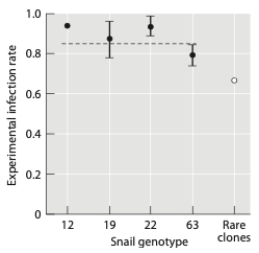Lively and Dybdahl studied parasite infection rates in a population of asexual clonal snails. The graph below shows relative infection rates for the four most common clone genotypes and for several rare genotypes (all lumped together) . Based on these data, they hypothesized that parasites adapted to infecting the most common clone genotypes in the population, and thus these genotypes had lower fitness. This is consistent with ________ operating in the population. Further evidence would be provided if ________. 
A) genetic drift; heterozygosity declined over time in the population
B) genetic drift; rare clones were lost from the population frequency-dependent selection
C) negative frequency-dependent selection; rare clones became common in the next generation but then declined in frequency in the following generation
D) negative frequency-dependent selection; rare clones became more common until they completely replaced the clones that were originally common
Correct Answer:
Verified
Q17: Why was Charles II of Spain, of
Q18: A genetic bottleneck occurs when
A) there is
Q19: Although the Ester1 allele confers a selective
Q20: In a population of butterflies that has
Q21: If a population is in Hardy-Weinberg equilibrium
Q23: The sickle-cell anemia allele, S, experiences strong
Q24: In the Hardy-Weinberg equation, p2 is
A) an
Q25: The effectiveness of selection on an allele
Q26: In the founder effect,
A) allele frequencies always
Q27: Genetic drift
A) will always lead to higher
Unlock this Answer For Free Now!
View this answer and more for free by performing one of the following actions

Scan the QR code to install the App and get 2 free unlocks

Unlock quizzes for free by uploading documents